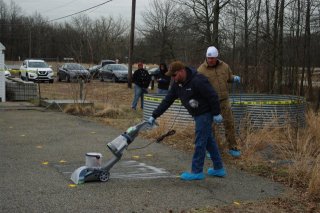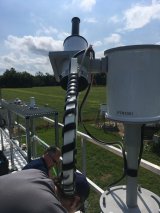EPA Research in New Jersey
EPA researchers are working hard to protect communities across the nation. Learn about some of the work EPA researchers are doing in New Jersey.
- Early Detection of Harmful Algal Blooms in New Jersey Communities
- Measuring PFAS Deposition from Air to Water
- Providing Data and Information to Cleanup a Mercury Contaminated Site
- Evaluating Sampling Protocols for Detection of Bacillus Anthracis in an Urban Area
- A New Era of Air Quality Monitoring from Space
- EPA Researchers Share Lessons Learned from Citizen Science Research Projects
- Using an Innovative Approach to Find PFAS in New Jersey's Environment
- Helping Community Drinking Water Systems Find Cost-Effective Solutions to Treatment Challenges
For more EPA work, see EPA in New Jersey.
Early Detection of Harmful Algal Blooms in New Jersey Communities
EPA developed the Cyanobacteria Assessment Network mobile app as an early warning indicator system for harmful algal blooms in U.S. freshwater systems. Since it’s release, the app has helped communities across the nation monitor harmful algal blooms and protect public health. New Jersey developed their 2020 Cyanobacterial Harmful Algal Bloom (HAB) Freshwater Recreational Response Strategy and incorporated data from the CyAN app into their screening process to inform continued response and confirmation actions. Read CyAN App Used for Early Detection of Harmful Algal Blooms in Communities Across the Nation.
EPA Researchers Provide Data and Information to Cleanup a Mercury Contaminated Site

In Harrison, New Jersey, an industrial complex known as the Vo-Toys site was found to be contaminated with elevated levels of mercury. EPA scientists helped the New Jersey Department of Environmental Protection determine what risk the facility posed to the community, especially in the case of a fire. EPA provided education to first responders about environmental and health dangers the site may pose and helped create an evacuation plan for the surrounding community in the case of a fire. Read EPA Researchers Provide Data and Information to Cleanup a Mercury Contaminated Site.
Measuring PFAS Deposition from Air to Water
In 2023, the New Jersey Department of Environmental Protection asked EPA researchers to help address the uncertainties around the atmospheric pathways of PFAS contamination of surface waters. EPA Office of Research and Development, in collaboration with the Office of Air and Radiation and federal partners such as USGS, has begun developing a standardized method for nationwide measurement of PFAS in precipitation. This nationwide approach will allow the state of New Jersey, along with several other state partners, to assess the extent to which PFAS contamination in water can be attributed to atmospheric emissions and precipitation. Read Measuring PFAS Deposition from Air to Water.
Evaluating Sampling Protocols for Detection of Bacillus Anthracis in an Urban Area

A hazardous material, including a chemical or biological agent, released into the environment can impact human and aquatic health long after the event. EPA researchers investigated the length of time that Bacillus anthracis surrogates could be detected on various outdoor surfaces and how weather conditions, particularly rainfall, play a role in the spread of hazardous contamination. EPA researchers conducted field studies using a non-toxic simulant spore at the EPA’s Urban Water Shed Facility, in Edison, New Jersey, the first study of its kind to compare the spore recovery from multiple sampling devices for a simulant of Bacillus anthracis over time in an outdoor environment. This research will help responders better understand when areas are safe for reentry after an incident. Read EPA Researchers Evaluate Multiple Sampling Protocols for Detection of Bacillus Anthracis in an Urban Area.
TEMPO: A New Era of Air Quality Monitoring from Space

Satellites are increasingly being used to monitor air quality and the movement of pollution in the air we breathe. The TEMPO project will allow researchers to observe pollutant emissions and see how pollution episodes evolve over hours, days, and weeks, interacting with weather patterns as they move across urban environments. EPA scientists are collaborating with NASA and other state and local agencies to build an air quality validation network of ground-based spectrometers, called Pandoras, at air quality sites across the country, including at the New Jersey Department of Environmental Protection air quality monitoring site at Rutgers University in New Brunswick, NJ. Read TEMPO: A New Era of Air Quality Monitoring from Space.
EPA Researchers Share Lessons Learned from Citizen Science Research Projects
Environmental Health Assessments (EHAs) are used to better understand the range of possible effects of environmental factors on a community’s health and wellbeing. These assessments are even more effective when researchers involve the community through citizen science. Using decades of experience conducting citizen science-based EHAs, EPA scientists have recently published paper on advice and frequently asked questions to help other communities conduct these assessments. In the study, researchers analyzed two case studies of citizen science-based EHAs, includign a citizen science air quality sensor project in Newark, New Jersey. Read EPA Researchers Share Lessons Learned from Citizen Science Research Projects.
Finding PFAS in the Environment
Per- and polyfluoroalkyl substances, known as PFAS, are chemicals used in countless consumer products. With so many types of PFAS in use, it can be difficult to find out which ones are persisting in the environment. EPA researchers used a new approach, non-targeted analysis, to help communities in New Jersey determine the impact of PFAS exposure. Read EPA Researchers Use Innovative Approach to Find PFAS in the Environment.
Helping Community Drinking Water Systems Find Cost-Effective Solutions to Treatment Challenges
Emerging contaminants, such as per- and polyfluoroalkyl substances (PFAS), are challenging to drinking water systems across the country. Effective treatment for emerging contaminants can be unknown, difficult, and extremely costly. Working with the state of New Jersey, EPA researchers are providing technical assistance to a very small community water system with PFAS concerns to help them identify optimal, cost-effective treatment methods and optimize the long-term operation of their chosen technology. These efforts will also be used to develop best practices and performance and cost estimate tools so water utilities across the country can make informed treatment and operational choices. Read Technical Assistance for Treatment Options to Remove Emerging Contaminants.
